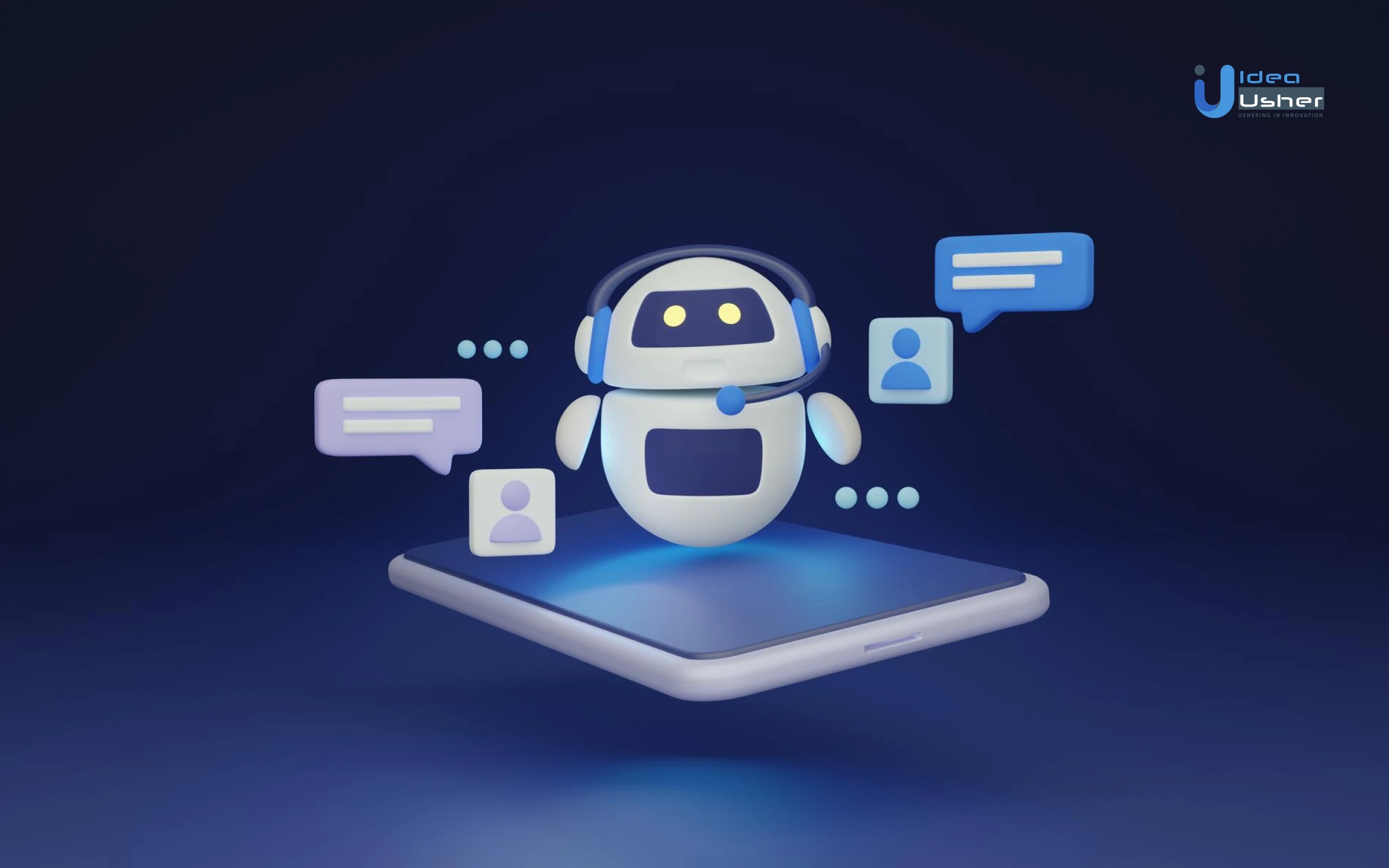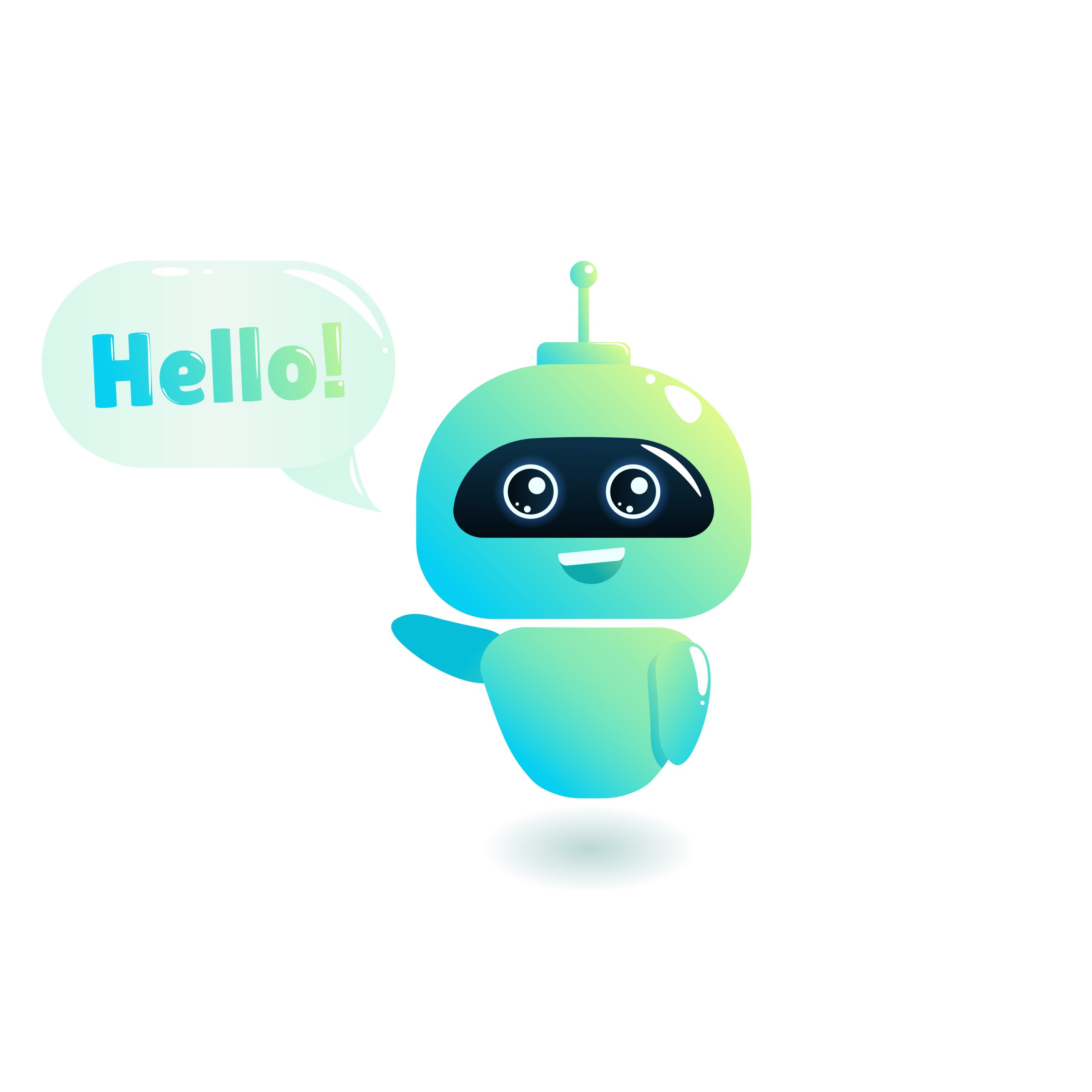The advent of AI has been an exciting journey for technology experts and aficionados alike. From its humble beginnings in the early 1900s, when researchers first began exploring the idea of using computers to replicate human thought, to its current state of sophisticated machines and applications, AI has come a long way. Today, it is used in various industries and applications, automating processes, providing deeper insights, and enhancing decision-making.
ChatGPT is an AI chatbot that uses natural language processing (NLP) technology to understand human language and respond to inquiries in a conversational manner. In this blog, we will understand the functioning of ChatGPT and its underlying technology and review its validity in modern-day AI use cases and perspectives.
All about ChatGPT AI
It is an artificial intelligence (AI) chatbot created by OpenAI. OpenAI is a research laboratory specializing in artificial general intelligence (AGI). The organization, founded in 2015, was initially created to ensure that the development and deployment of artificial intelligence technologies remain safe and beneficial to humanity.
As such, OpenAI has created a suite of AI technologies to explore the space of general AI. One of these technologies is ChatGPT, an AI-powered chatbot capable of understanding and responding to natural language. It was created to provide a general conversational AI platform that anyone can use to create their own AI-powered chatbot. Infusing natural language processing, machine learning, and deep learning, this AI was designed to help people create and train their own AI chatbot with minimal effort. It is also designed to learn from its conversations and become smarter over time. The technology was also designed to be extensible, meaning users can add to its capabilities as they see fit.
How does it work?
Three core elements make up this futuristic chatbot. These are NLP, Neural Networks, and the foundational GPT model.
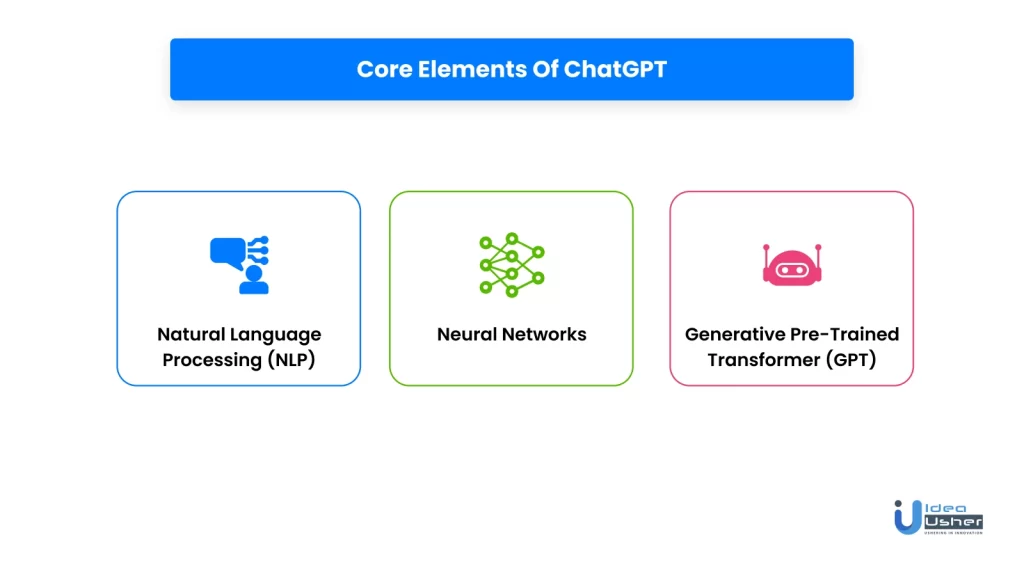
Natural Language Processing (NLP)
Natural Language Processing (NLP) is a branch of Artificial Intelligence that focuses on interacting with computers through natural language. It attempts to understand and process human language, including the meaning and structure of the words used.
NLP is an area of AI that focuses on enabling computers to interpret, understand, and generate human language. It comprises two primary components: natural language understanding (NLU) and natural language generation (NLG). NLU analyzes and interprets natural language inputs and maps them to useful representations, while NLG produces meaningful phrases and sentences from an internal representation. This process requires text planning, extracting relevant content from a knowledge base, sentence planning, selecting the appropriate words, and forming meaningful phrases. Finally, text realization transforms the sentence plan into a proper sentence structure.
ChatGPT uses a distinctive type of NLP called transfer learning to generate natural-sounding responses to user input. Transfer learning involves training a model on a large set of data from various sources, such as conversations or texts. This helps the model to understand how to respond to user input and generate natural-sounding responses. ChatGPT also uses other techniques, such as sentence structure analysis and word embedding, to generate more natural responses. Combining these techniques allows the bot to generate natural and relevant responses to user input.
Neural Networks
Neural networks are artificial intelligence based on the structure and functions of biological neural networks. They are the foundation of deep learning and are used for various machine learning tasks such as image classification, object detection, language translation, and natural language processing. They can process large amounts of data, identify patterns, and make predictions.
Neural networks have been used in ChatGPT (Generative Pre-trained Transformer) to create a language model. This model generates text related to a given topic and helps computers understand natural language. It is based on the Transformer architecture and uses an encoder-decoder architecture to generate text. The encoder is used to read the input text, and the decoder is used to generate the output. The model is trained on a large corpus of text, such as books, news articles, and web pages. The model is then used to generate text related to the given topic.
Generative Pre-trained Transformer (GPT)
Developed first ever by the same house of Open-AI, Generative Pre-trained Transformer (GPT) is an unsupervised, deep learning approach to natural language processing that uses a transformer architecture to generate text from a given input.
In contrast to traditional language models predominantly utilized across the AI domain, GPT was made specifically to depend upon unlabeled data for training, making it much more flexible to generate text from any given input.
ChatGPT is built on the foundation of GPT v3.5, an advanced version of GPT-3 found in OpenAI’s playground. GPT-3.5 has an improved architecture that allows for greater accuracy when it comes to language understanding, in addition to being able to generate more natural-sounding text. It also has an increased number of parameters, which means it can store more information and generate more complex text. Lastly, GPT 3.5 has improved performance on tasks such as question answering and summarization.
How is the AI trained?
When we talk about training ChatGPT, the bot is trained using supervised and unsupervised learning techniques. For supervised learning, the model is trained on a large corpus of text, such as the Common Crawl corpus, using a technique called masking.
During masking, the model is given a sentence with some words removed and must predict the missing words. This helps it learn the context of words and their use in a sentence. For unsupervised learning, the algorithmic bot is trained using a technique called generative pre-training. This involves training the model on a large corpus of text without any labels or tags. The model then learns to generate text based on patterns seen in the text. This helps it generate more natural language as it learns to recognize the structure and context of sentences.
Once the model is trained, it can generate text responses to user queries. The model can be fine-tuned for specific applications, such as dialogue systems, by training it on a large corpus of dialogues. This allows the model to learn the structure and context of conversations, making it more effective at responding to user queries.
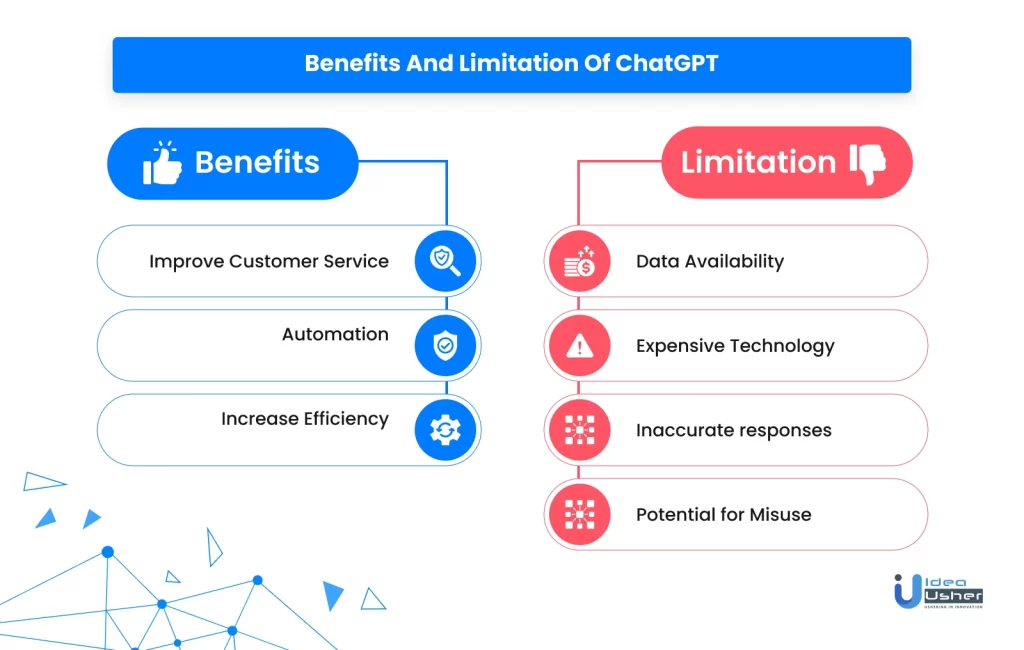
Benefits of ChatGPT
If rightfully implied, there are endless ways to leverage this AI bot. From exquisitely personified information query assistance to automated customer service, this revolutionary chatbot can greatly aid in lessening human efforts. Although the foundational vision behind the development of AI was to:
Improve Customer Service
ChatGPT enables businesses to provide a more personalized customer service experience by offering automated conversations tailored to customers’ needs. This helps improve customer satisfaction by providing a more efficient way to solve customer queries and issues. AI can also help businesses identify customer trends, allowing them to target their marketing strategies.
Automation
ChatGPT can automate tasks that are usually done manually, such as customer support, data entry, and customer segmentation. This can help reduce the time, resources, and costs needed to complete tasks, leading to more efficient operations. Automation also helps to reduce errors, as it eliminates the possibility of human error.
Increase Efficiency
ChatGPT can help businesses to increase their efficiency by cutting down on the time needed for customer service and data entry. This, in turn, leads to improved customer satisfaction, as customers will be able to get their queries answered faster and more accurately. This can help businesses quickly identify and respond to customer trends, allowing them to optimize their marketing strategies.
Limitations of ChatGPT
As a language model, ChatGPT does not have the ability to access the internet or browse online content. This means it is limited to the information it has been trained on, including a vast amount of text data from various sources. However, because it is not connected to the internet, it cannot access new information or update its knowledge base with the most current information.
This can limit its ability to provide accurate and up-to-date responses to questions. It can also not access personal experiences or information about current events, which can also impact its ability to provide useful responses to certain types of questions. This fetches with ChatGPT several challenges:
Data Availability
Data availability is a significant challenge for ChatGPT AI. Without sufficient data, the AI cannot accurately recognize and respond to user input. To ensure that the AI can accurately interpret user input and provide an appropriate response, it must be trained on large datasets of conversation transcripts. This can be expensive, time-consuming, and requires a significant investment of resources.
Expensive Technology
The technology required to power ChatGPT is expensive and complex. This can make it difficult for companies and organizations to afford the technology and find the resources necessary to build and maintain the AI.
Additionally, customizing the backend APIs and employing them for additional functionalities would require extensive skilled expertise and substantial financial backing. Finally, ChatGPT requires regular updates and maintenance, which can be costly and time-consuming.
Inaccurate responses
ChatGPT is a language model, not a fact-checking model. It is trained to generate text with consistent language patterns rather than to verify its accuracy against real-world facts. As such, it is likely to generate text that appears to make sense but is not necessarily factually correct.
Potential for Misuse
ChaT-GPT has the potential to be misused, which can have serious consequences. For example, malicious actors could use AI to spread misinformation or manipulate people.
Additionally, the AI could be used to invade users’ privacy, as it is capable of recording and analyzing conversations. To prevent misuse, organizations must have clear policies in place and ensure that AI is used responsibly.
Google vs. ChatGPT: Who’s Better Among The Two
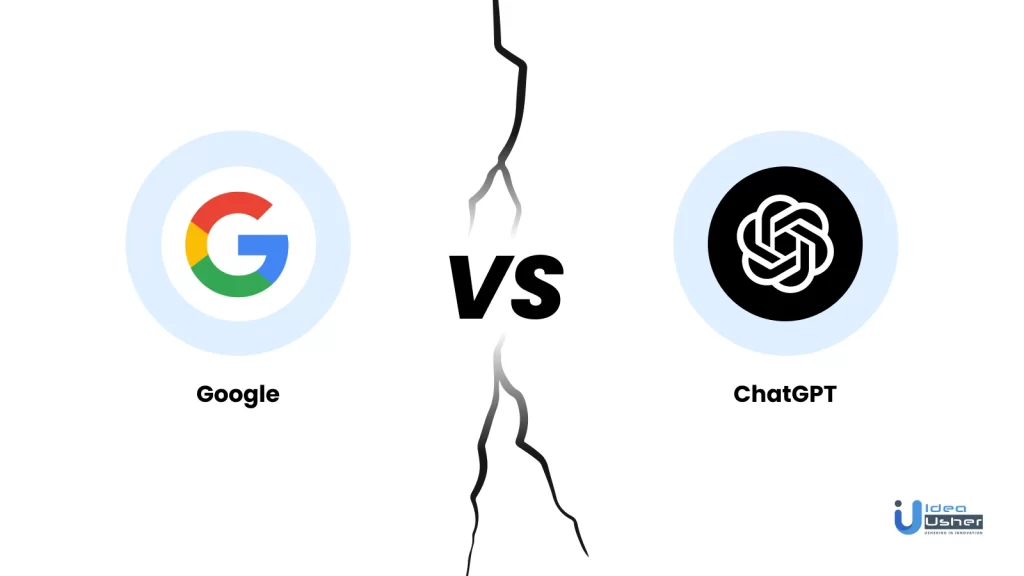
This has perhaps become one of the most prevalent questions in recent times and a legit dilemma among the users of both the technology. But to answer the question factually, we need to consider the creative visions behind the two.
In the late 1990s, when Google was founded, the internet was still a relatively new and unexplored frontier. There were countless websites but no easy way to find what you were looking for. Search engines at the time were slow and unreliable, often returning irrelevant or spammy results.
In this context, the founders of Google, Larry Page, and Sergey Brin saw an opportunity to create something better. They set out to build a search engine that could understand the relationships between different pieces of information and use that understanding to deliver more relevant and useful results.
Leveraging the revolutionary algorithm called PageRank, which analyzed the links between different websites to determine their relative importance. This allowed Google to deliver more relevant results by ranking websites based on the number and quality of other sites that linked to them.
Since then, Google has continued to evolve and expand, incorporating new technologies and data sources to improve its search results and branching into new areas such as email, maps, and mobile devices. But at its core, the company remains true to its original mission of organizing and making sense of the world’s information.
ChatGPT, on the other hand, is a much more specialized tool. It is an artificial intelligence chatbot that allows users to have natural conversations with a computer. By training it on specific topics, users can get very specific answers to their questions quickly and easily.
There are many layers to machine learning and natural language processing involved within, and the specific layers used can vary depending on the task at hand. However, some common layers include:
- Data pre-processing: This involves cleaning and preparing the data for use by the model, such as by removing noise or formatting the data in a specific way.
- Feature extraction: This involves identifying and extracting relevant features from the data that can be used by the model to make predictions.
- Model training: This involves using the extracted features to train a machine learning model, such as a neural network or decision tree, to make predictions.
- Model evaluation: This involves evaluating the performance of the trained model on a separate test dataset to see how well it generalizes to new data.
- Model optimization: This involves adjusting the model’s hyperparameters or adding additional layers or features to improve its performance.
- Inference: This involves using the trained and optimized model to make predictions on new data.
In the context of natural language processing, there are often additional layers that are specific to processing and understanding text. These can include:
- Tokenization: This involves dividing the text into smaller units called tokens, which can be words, phrases, or even individual characters.
- Part-of-speech tagging: This involves identifying the role that each word plays in the sentence, such as whether it is a noun, verb, or adjective.
- Named entity recognition: This involves identifying and extracting specific named entities from the text, such as people, organizations, or locations.
- Sentiment analysis: This involves identifying the text’s sentiment or emotional tone. But its goal has never been to replace Google. It was simply developed to answer questions with a story-like eloquence, enabling users to engage in meaningful conversations in seconds.
The two services hence are very different and serve different purposes. While ChatGPT can provide useful assistance, it cannot replace the all-encompassing power of Google. Google has a much larger database of information, and its algorithms are designed to provide the most relevant results to searches. It can also answer more complex questions, such as searches for images, videos, maps, and anything that can exist digitally.
Implementation use cases for ChatGPT
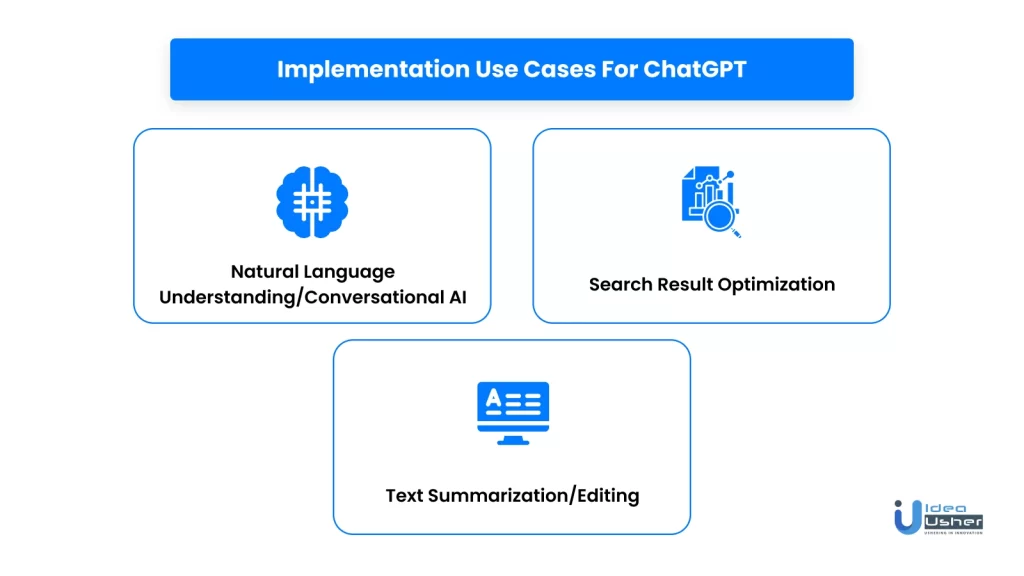
There are numerous implementation potentials for the revolutionary chatbot and its underlying GPT-3 model for industries and businesses. Below mentioned are some of the prime application integration use cases:
1. Natural Language Understanding/Conversational AI
ChatGPT can create conversational AI with natural language understanding, allowing mobile applications to respond to user queries and provide more engaging experiences. E-commerce apps can use it to understand user queries and intent, allowing for more efficient customer support. Food-based companies can develop conversational ordering systems for mobile applications, enabling customers to order food without navigating through a complex ordering interface. Real-life implementations of such include automobile company Audi, Japanese app development company Gumi, and Australian airlines Qantas. Each of these companies uses the bot to power their conversational AI to understand user queries and generate dynamic responses.
2. Search Result Optimization
ChatGPT can also generate natural language responses for mobile applications or help navigate user searches for more contextual and personalized search results. A streaming service named Pluto TV has implemented the chatbot to power its natural language search engine, allowing users to find content more easily.
3. Text Summarization/Editing
Finally, ChatGPT can be used to generate summaries for long pieces of text, such as news articles or blog posts. This can be used to make text easier to consume for mobile applications. NewsCred, for example, is a news aggregator app that has implemented a chatbot to generate summaries for news articles, allowing users to quickly get the gist of an article without having to read the entire thing.
It can also help with succinct and efficient editing of texts, paraphrasing, revamping, and likewise, which can be a practical privilege for writing-related professionals and businesses.
Final verdict: Boon or Bane
While majorly used for simple information transmission purposes, the technology has the potential to revolutionize communication, making it faster and more efficient than ever before. This could provide a great benefit to those who are looking to get their messages across quickly and effectively. By utilizing natural language processing and artificial intelligence, it can understand the context of conversations and respond promptly. This could be especially useful for businesses, or other large institutions, where time is of the essence.
On the other hand, however, to build app like ChatGPT which also has the potential to create a disconnect between people, removing the need for human-to-human interaction. The reliance on technology could lead to less meaningful conversations and more shallow relationships. Additionally, there is the risk of data privacy and security, as ChatGPT may have access to sensitive and confidential information.
Conclusion
If humanity were to look beyond the horizon of today, we would find that the future of Artificial Intelligence (AI) is brighter than ever. AI has the potential to revolutionize the way we live and work, from healthcare to transportation. It has already begun to shape the future of many industries, and evidently, its impact will only grow as technology advances.
The potential of AI to revolutionize our daily life is immense, but it will take time for the technology to mature. As it continues to advance, we will likely see more of its applications in other fields. ChatGPT is simply an early iteration of what AI could offer to humankind. Future prospects of AI’s capabilities are ubiquitous but can be equally devastating.
Get in touch with us now!
Build Better Solutions With Idea Usher
Professionals
Projects
Contact Idea Usher at [email protected]
Or reach out at: (+1)732 962 4560, (+91)859 140 7140
FAQs
What is ChatGPT AI?
It is an artificial intelligence technology that uses natural language processing to generate conversations from a given input. It is a generative language model developed by OpenAI that uses machine-learning techniques to generate human-like conversations. The algorithmic bot is used to create interactive chatbots that can provide helpful customer service or generate entertaining stories and conversations.
Is ChatGPT free?
The chatbot is currently in its research phase, so users can use ChatGPT for free. However, users need to pay for premium features to use its advanced services. These features include creating custom conversation flows specific to the business domain, enacting the chatbot as personalized customer support, and so on.
What is GPT-3?
GPT-3 (Generative Pre-trained Transformer 3) is an artificial intelligence system developed by OpenAI. It is a language model that uses deep learning to produce human-like text. GPT-3 is the successor to GPT-2, which was released in 2019. It has been trained on a dataset of 45TB of text, making it the largest language model ever created.
What language is GPT-3 written in?
The source code for GPT-3 has yet to be released, but the creators have reported that it uses the same model and architecture as GPT-2, albeit with some exceptions. The code for GPT-2 is written in Python, using libraries based on C and C++, such as Tensorflow and NumPy. It is likely that GPT-3 is also written in Python, making use of C-based libraries.
